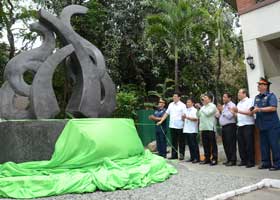‘One in every three DENR execs is a woman’
Secretary Ramon J.P. Paje has announced that about one-third or 33 percent of management positions in the Department of Environment and Natural Resources (DENR) are now occupied by women.
Paje said women currently hold 269 of the 798 management positions in the agency, or 251 percent higher from the 107 positions recorded in 2008.
As the country observes Women’s Month this March, Paje said it is only fitting that the DENR recognize the important role of women in society and nation-building.
He said the growing number of women with management roles in the environment department was largely due to the Aquino administration’s strong commitment to Gender and Development to ensure fairness and equity in the workplace, allowing women to compete with men on equal basis.
“Gender equality has been a major policy that I pursued when I assumed office in 2010, and whatever accolade or recognition the DENR has been receiving either from local or international bodies is greatly attributed to the increasing role that women play in the DENR organization,” Paje said.
Paje noted that in 2012, the DENR received a “double upgrade” in a survey conducted by the Social Weather Stations (SWS) on corruption, based on interviews with 826 company executives representing large, medium and small enterprises nationwide. It was the first time since 2005 that the DENR got a positive rating in that survey.
Also in 2012, the Philippines ranked 42nd among 132 countries under the “strong performer” category in the Environmental Performance Index (EPI) prepared by Yale and Columbia Universities.
Just recently, the DENR central office became the first institution in the country to receive ISO 14001:2015 Certification from the International Organization for Standardization (ISO), a Switzerland-based international standard-setting body composed of representatives from national standards organizations of 164 member-countries.
ISO 14001 is an internationally agreed standard that sets out the requirements for an environmental management system. It helps organizations improve their environmental performance through more efficient use of resources and reduction of waste, gaining a competitive advantage and the trust of stakeholders.
Paje said these achievements would have not been possible without the support of DENR women executives, who supervise offices that are directly responsible for the implementation of environmental policies and programs.
He noted that “80 percent of assistant bureau directors are now occupied by women, and 37 percent of the division chiefs are women.”
According to the DENR’s Statistics and Data Resource Management Office, female top executives rose to 38 this year from 36 in 2015, ranging from the Secretary down to Bureau Directors and Assistant Directors, Administrators, General and Assistant General Managers and Service Directors, including Regional Directors (RDs) and Assistant Regional Directors (ARDs) and Provincial Environment and Natural Resource Officers (PENROS).
Female middle managers, consisting of Divisions Chiefs and Community Environment and Natural Resources Officers (CENROS), rose from 196 to 231 from 2015 to 2016, respectively.
Meanwhile, the DENR has awarded housing units to 55 employees, 34 of them are women, under the agency’s housing project dubbed Project HOPE.
This brings to 2,574 the total number of DENR workers who have availed of the housing units since the project was launched in 1998.
Project HOPE was launched in 1998 after the then Philippine Estates Authority (PEA) transferred to the DENR the housing units, which were part of the 21,000 socialized housing units built through a joint venture agreement between PEA and Filinvest Development Corporation in 1993.
Three more housing projects are being developed by the DENR management for its employees to avail, namely: the Garden Cottages in Tanay, Rizal (130 hectares); the National Mapping and Resource Information Authority Housing Project in Taguig City (5.7 hectares); and the Government Employees Housing Project in Muntinlupa City (78 hectares). #
- Details
- Parent Category: News & Events
- Category: Press Releases





